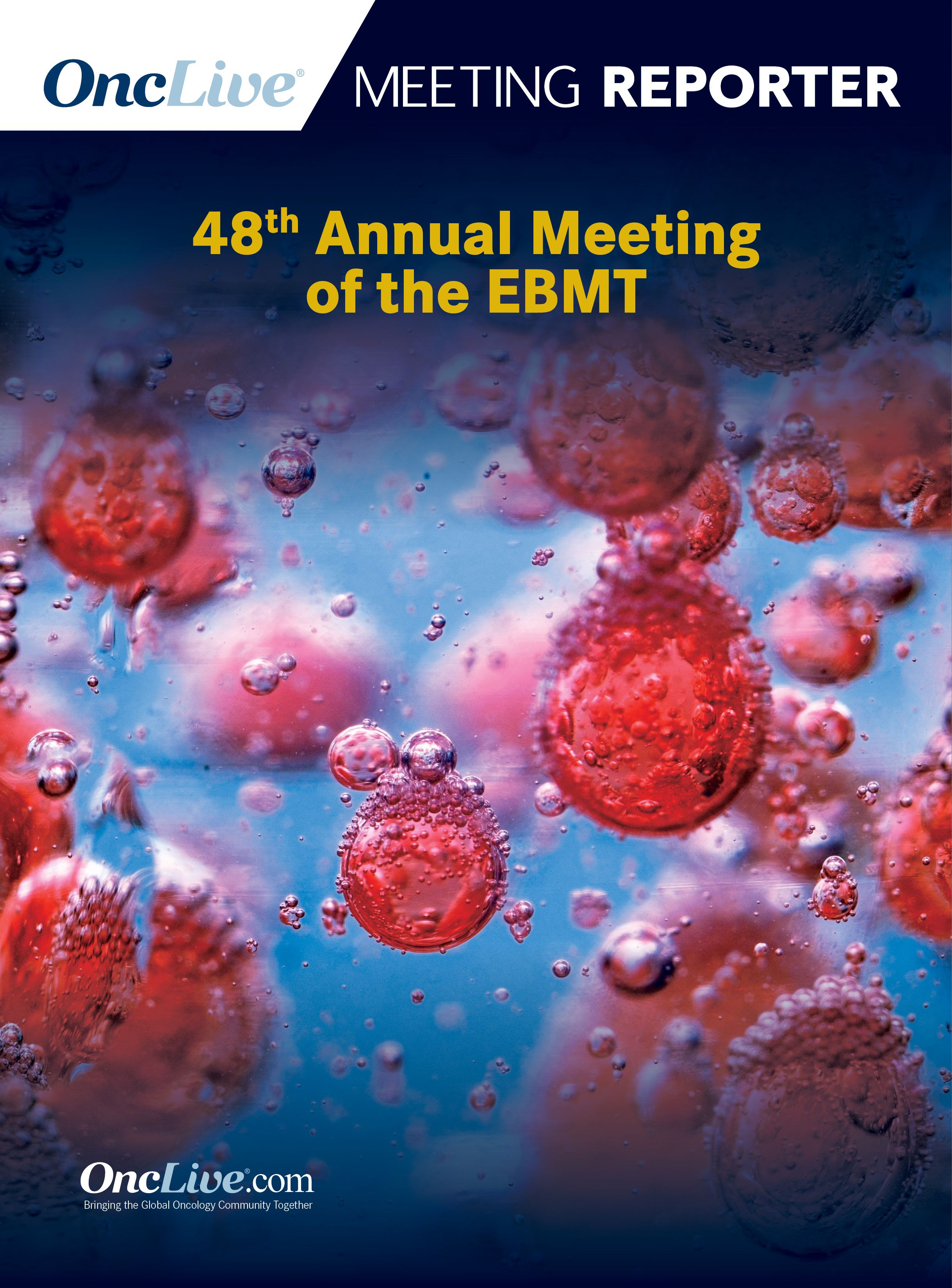Publication
Article
Axi-Cel Shows Clinically Meaningful Improvement in QOL in Second-Line Relapsed/Refractory LBCL
Author(s):
Axicabtagene ciloleucel demonstrated a clinically improvement in quality of life compared with standard of care chemotherapy in the second-line setting for patients with relapsed/refractory large B-cell lymphoma.
Mahmoud Elsawy, MD, MSc

Axicabtagene ciloleucel (axi-cel; Yescarta) demonstrated a clinically improvement in quality of life (QOL) compared with standard of care (SOC) chemotherapy in the second-line setting for patients with relapsed/refractory large B-cell lymphoma (LBCL), according to patient-reported outcome (PRO) data of the phase 3 ZUMA-7 trial (NCT03391466).
The findings, which were presented during the 48th Annual Meeting of the EBMT, showed that the QOL benefit with the CD19-directed CAR T-cell therapy was observed at day 100 as measured by multiple validated PRO instruments.
“The superior clinical outcomes and patient experience with axi-cel over SOC should help inform treatment choices in second-line [relapsed/refractory] LBCL,” lead study author Mahmoud Elsawy, MD, MSc, of Queen Elizabeth II Health Sciences Centre and Dalhousie University in Canada, and coinvestigators, wrote in a poster presented during the meeting.
Clinical outcomes are poor for patients with LBCL who experience early relapse or are refractory to frontline therapy, and the second-line SOC treatment is often linked with poor health-related QOL. Axi-cel is currently FDA approved for the treatment of adult patients with relapsed/refractory LBCL after at least 2 lines of systemic therapy.
In the multicenter, open-label, phase 3 ZUMA-7 trial, investigators evaluated axi-cel vs SOC in patients with relapsed/refractory LBCL in the second-line setting.
A total 359 patients across 77 sites were randomized 1:1 to receive axi-cel plus conditioning chemotherapy (n = 180) or SOC with investigator-selected platinum-based chemoimmunotherapy (n = 179). At day 50, an initial disease assessment was conducted; those who were on the axi-cel arm continued to day 100, day 150, and long-term follow-up. Patients who had either a complete or partial response to SOC proceeded to high dose chemotherapy (HDT)-autologous stem cell transplant (ASCT). Nonresponders received additional treatment off protocol.
To be eligible for enrollment, patients had to be at least 18 years old, have LBCL that was relapsed/refractory within 12 months of frontline therapy, and intended to proceed to HDT-ASCT. Stratification factors included response to first-line therapy and second-line age-adjusted International Prognostic Index (sAAIPI) score. It was optional to include steroid-only bridging therapy without chemotherapy.
Primary efficacy findings of the trial were presented at the 2021 ASH Annual Meeting.2 At a median follow-up of 24.9 months, findings showed that the median event-free survival (EFS) was 8.3 months (95% CI, 4.5-15.8) for patients on axi-cel compared with 2.0 months (95% CI, 1.6-2.8) for those on SOC chemotherapy (HR, 0.40; 95% CI, 0.31-0.51; P < .001). The 2-year EFS rates in the investigative and control arms were 40.5% (95% CI, 33.2%-47.7%) and 16.3% (95% CI, 11.1%-22.2%), respectively. The EFS benefit was observed across key patient subgroups.
The data presented at the 48th Annual Meeting of the EBMT encompassed the first comparative analysis of PRO with axi-cel compared with SOC in this patient population.
The instruments that were utilized included: European Organization for Research and Treatment of Cancer (EORTC) Quality of Life Questionnaire‑Core 30 (QOLC-C30), a 30-item cancer-specific questionnaire that included global health status, functional, and symptom scales; EQ-5D-5L, a general questionnaire with 5 QOL domains along with a global assessment; and Work Productivity and Activity Impairment (WPAI): General Health, which measures work productivity and activity impairment.
The assessments were taken at baseline, day 50, day 100, day, 150, month 9, and every 3 months thereafter from randomization up to 2 years or time of EFS event—whichever occurred first. The analysis population included all patients who had a baseline PRO and at least 1 measure completed on days 50, 100, or 150. Clinically meaningful changes were noted as being 10 points for each EORTC QLQ-C30 score, 7 for EQ-5D-5L Visual Analogue Scale (VAS) score, and 0.06 for EQ-5D-5L score. Additional exploratory analyses were also conducted.
Regarding baseline characteristics of the QOL analysis set (n = 296), 30% of patients were aged at least 65 years old and 42% of patients had an sAAIPI score of 2 to 3. Seventy percent of patients had primary refractory disease, and patients either had high-grade B-cell lymphoma (double-/triple-hit; 19%), had negative double-/triple-hit status (60%), or were not tested (21%).
Results showed that for patients treated with axi‑cel compared SOC, there was a statistically significant and clinically meaningful difference in mean change of scores from baseline at day 100, favoring axi-cel, on all prespecified PRO domains, including EORTC QLQ-C30 Physical Functioning (P <.0001), EORTC QLQ-C30 Global Health Status/QOL (P <.0001), and EQ-5D-5L VAS (P <.0001). At day 150, the P values were .0124 and .0004 for EORTC QLQ-C30 Global Health Status/QOL and EQ-5D-5L VAS, respectively. Sensitivity analyses that controlled for covariates and patterns of missingness also demonstrated similar findings at day 100.
Furthermore, the mean estimated scores for patients on the axi‑cel arm returned to or exceeded scores at baseline by day 100 to day 150 compared with month 9 or later for those on the SOC arm.
Regarding the exploratory analyses, axi-cel also showcased statistically significant differences in change from baseline for nausea and vomiting, diarrhea, insomnia, and appetite loss measures at day 100; role functioning at day 100 and day 150; and social functioning, fatigue, and dyspnea measures at day 100, day 150, and month 9.
Finally, in terms of work productivity and activity impairment, patients on axi‑cel had statistically significant (P < .05) lower mean absenteeism and lower mean activities impairment at day 100 vs SOC.
The authors noted, however, that score comparisons at later time points warrant cautious interpretation because “attrition due to disease progression, new lymphoma therapy, or death was disproportionately higher on the SOC arm and may select patients with the best outcomes.”
“The data also suggest faster recovery to pretreatment QoL with axi‑cel compared with SOC,” the authors concluded.
References
- Elsawy M, Chavez JC, Avivi I, et al. Patient‑reported outcomes in ZUMA‑7, a phase 3, randomized, open‑label study evaluating the efficacy of axicabtagene ciloleucel (axi‑cel) versus standard‑of‑care therapy in relapsed /refractory large B‑cell lymphoma. Presented at: 2022 EBMT Annual Meeting; March 19-23, 2022; virtual. Abstract P104.
- Locke FL, Miklos DB, Jacobson CA, et al. Axicabtagene ciloleucel as second-line therapy for large B-cell lymphoma. N Engl J Med. 2022;386(7):640-654. doi:10.1056/NEJMoa2116133.










